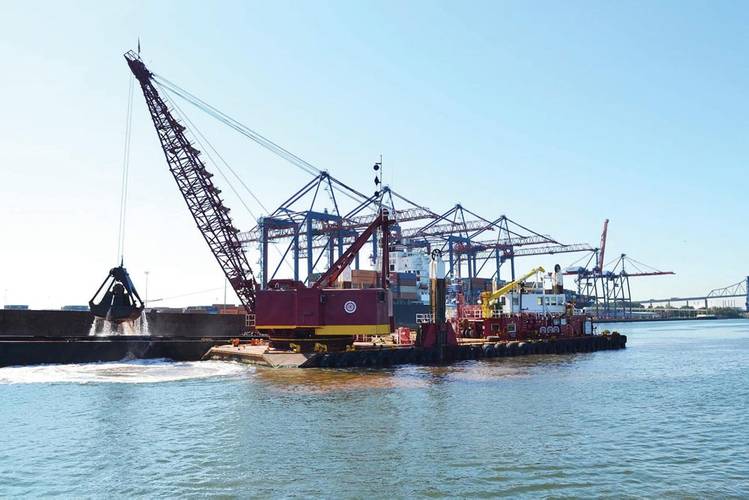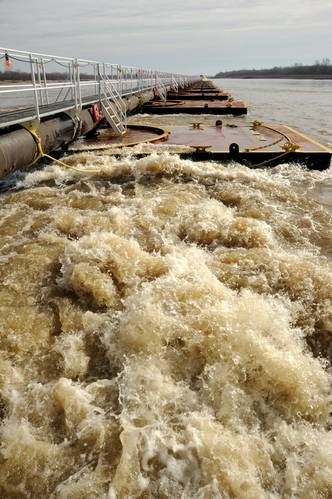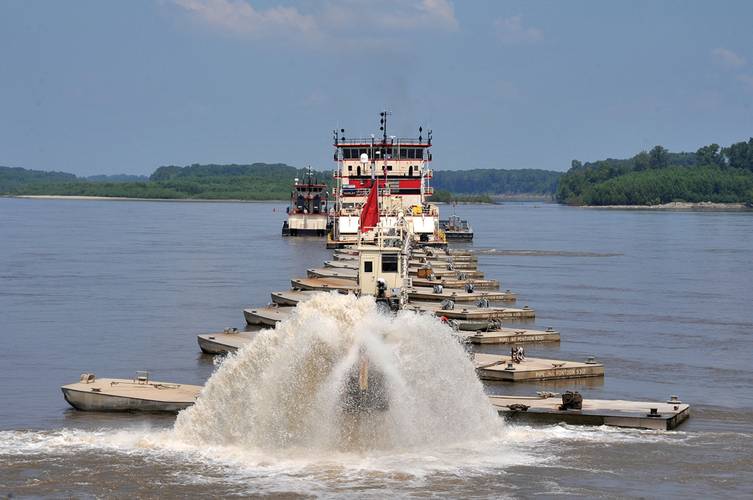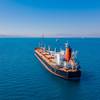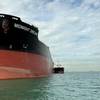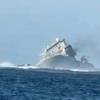US Dredging Needs Growth as Army Corps’ Budget Shrinks
Spend dollars up on dredging, cubic yards moved down. Combined with a reduction in the USACE federal budget, the situation threatens a perfect storm for domestic requirements.
U.S. dredging this decade, measured in cubic yards, is only half as active as it was in the early 1960s, with maintenance down slightly since then and new work off considerably, according to the U.S. Army Corps of Engineers or USACE. The nation’s spending on dredging in unadjusted dollars has swelled tenfold since the 1960’s, however. Because domestic dredging is protected by the Jones Act, companies must be owned by U.S. citizens, employ Americans and use equipment built here.
Dredging SITREP: June 2014
The FY 2015 civil works budget at USACE, the federal agency most engaged in dredging, is smaller than in 2014. Members of Congress this spring expressed concern about the new budget. The United States is lagging a number of nations in port modernization and needs to do more deepening to fully participate in global trade, they said. And, this goes beyond the need to deepen deep draft coastal ports. Inland rivers, vital to moving raw materials and grain to the export markets, need constant attention.
Factors driving world dredging, including growth in sea trade, bigger container ships, climate change and sea level rise have kept U.S. dredging from declining further. Globally, port and harbor expansions, new ports, enlarged navigation channels and maintenance work account for nearly three-fifths of dredging activity. Data obtained from the USACE for actual costs and dredging activities dating back to 1963 shows activity down, but costs soaring.
China, the world’s largest dredge market, and the United States are both “closed” or inaccessible to foreign competitors, Netherlands-based Rabobank noted in its dredging outlook in September. European dredge markets are mostly open; non-Chinese Asian markets are mixed; and Latin America, the Middle East and Australia are open. In the most recent data available, China accounted for 29 percent of world dredging work in 2011, followed by Europe with 13 percent. Since then, China’s CCCC, the parent company of dredgers CHEC, has signaled plans to become more active in global dredging.
Climate Change Stimulates Dredging
Storm damage and protecting against climate change have raised demand for dredging, Rabobank said in September. A 2011 UN report assessing climate impacts estimated that 40 million urbanites live in 100-year floodplains, where the chance of a severe flood is once every 100 years. That number could grow to 150 million people by 2070. In terms of property and infrastructure value, Miami, Fla., followed by Guangzhou, China and New York are the cities most exposed to sea level rise and storms, Rabobank said.
In 2012, Hurricane Sandy caused $50 billion worth of damage, and Katrina in 2005 inflicted $128 billion in losses in equivalent dollars. No value, of course, can be placed on lost lives. Rabobank noted that the cost of installing a good defense system before Sandy hit was an estimated $6.5 billion in 2009 – only a fraction of the dollar value of damage caused by the storm. Governments need to take measures to protect populations from sea level rise and hurricanes, the bank warned in September.
Sea Trade & Ship Size Expand, Driving Dredging
Between 1977 and 2011, global GDP rose by 3.2 percent annually and seaborne trade grew 3.1 percent while the number of containers on ships surged 9.7 percent yearly, according to Rabobank. Growth in seaborne trade and containerization have together spurred investment in deepening, expanding and building ports and enlarging channels.
Of the millions of tons of goods shipped globally each year, crude oil accounts for over 20 percent and containers for over 15 percent, followed by iron ore, coal and LNG. Very large crude carriers or VLCCs and ultra-large crude carriers or ULCCs, both introduced in the 1970s, have sparked port expansion and dredging. And ever-larger vessels for containers, which were launched in 1966, have greatly boosted dredging demand. To maximize economies of scale, dry goods are increasingly shipped via containers. As container vessels grow, customers benefit from lower costs, raising demand for goods and prompting investment in even bigger boats.
In 1980, the world’s largest vessels shipped 4,100 TEUs or twenty foot containers, and by 2012 that had ballooned to15,000 TEUs. As of 2014, seven of Denmark-based Maersk “Triple E” containerships, with a capacity of 18,000 TEUs and a draft of 14.5 meters or 48 feet, were in service globally, with more about to be delivered by the company or under construction. They’re too big for the Panama Canal’s new dimensions and most American ports, but can transit the Suez Canal for trips between Europe and Asia.
After the Panama Canal’s expansion is finished in 2015, container vessels of up to 13,000 TEUs with a maximum draft of 15 meters, a length up to 366 meters and a width of 49 meters can be accommodated.
Most of the world’s busiest ports, including Long Beach and Los Angeles in California, can handle huge container vessels with a draft of 14.5 meters. Rotterdam’s heavily dredged Maasvlakte II port is 20 meters deep. U.S. ports, including New York City, Norfolk and Baltimore, have increased depths to at least 15 meters or 50 feet, and the Port of Miami is doing so now.
Port Deepening & Post-Sandy Work
The biggest U.S. dredging projects now are maintenance work, port deepening and activity following Sandy in October 2012. When asked about projects, Barry Holliday, executive director of trade group Dredging Contractors of America in Washington, DC, said: “Currently the top two jobs in dollars are $174,111,456 for Miami Harbor deepening, awarded in May 2013 and expected to continue until mid-2015, and $68,681,500 for deepening the Arthur Kill in New York/New Jersey Harbor, awarded in January 2013 and to be completed this year.”
He noted that Congress appropriated $1.086 billion in FY 2014, up slightly from the previous year, to USACE for navigation projects reimbursed by the Harbor Maintenance Trust Fund. The federal Harbor Maintenance Tax, established in 1986, is imposed on shippers based on the value of goods moving through ports. The tax is no longer collected on exports. Revenue is placed in a trust fund to be used for maintenance dredging of federal navigation channels. HMTF revenue has grown in the past decade but ports, shippers and dredgers complain that some of the money has been used to offset other federal spending.
Holliday said the Hurricane Sandy Emergency Supplemental Appropriations bill or H.R. 152, signed into law in Feb. 2013, included about $600 million for maintenance dredging projects in 2013/14 and more than $1 billion for beach replenishment. Deepening the Arthur Kill is part of a project, dating back to 1986, between the Port Authority of New York and New Jersey and USACE, to accommodate big container ships. Estimated project costs for NY/NJ Harbor Deepening, including non-federal shares, total $2,675,256,800 since 2002, according to Army Corps spokesman Gene Pawlik in Washington, DC. Deepening of the NY/NJ Harbor should be finished in March 2016. All of its project components were funded separately before FY 2002, Pawlik said.
Another major dredge project is deepening of the Delaware River shipping channel from 40 to 45 feet. Delaware deepening, estimated at $338,948,000 including non-federal sharing, should be finished in 2017, if fully funded, Pawlik said. Under a 2008 partnership, the cost of initial construction is 35 percent covered by the Philadelphia Regional Port Authority and 65 percent by USACE. The project, which benefits five Pennsylvania ports and the ports of Wilmington, Del. dates back to FY 1992.
USACE’s FY 2015 Budget Is Smaller
The FY 2015 budget for USACE’s civil works program is $4.561 billion in gross discretionary funding, down $265 million or 5.5 percent from FY 2014’s $4.826 billion, Pawlik said. With total funding from all sources-- including Rivers and Harbors Contributed Funds, Federal Permanent Appropriations and the Coastal Wetlands Restoration Trust Fund--the agency’s FY 2015 civil works budget is $4.959 billion, $264 million less than in FY 2014.
The enacted FY 2014 appropriation for USACE’s civil works program was $5.467 billion, Pawlik said. Compared with FY 2014’s enacted appropriation, the 2015 budget of $4.561 billion is down $906 million or 16.6 percent.
Of USACE’s $4.561 billion in FY 2015 gross discretionary funding for civil works, $3.517 billion is from a general fund; $915 million is from the Harbor Maintenance Trust Fund; $85 million is from the Inland Waterways Trust Fund and $44 million is from Special Recreation User Fees, Pawlik said. Other sources are estimated at $398 million, with $300 million from non-federal interests such as the Rivers and Harbors Contributed Funds and $20 million in permanent appropriations. Another $78 million is available from the Coastal Wetlands Restoration Trust Fund for the work of several federal agencies, including USACE, and is overseen by a federal-state interagency task force led by USACE.
The President’s FY 2015 budget includes $1.825 billion for USACE’s navigation program, below $1.884 billion in FY 2014, Pawlik said. It provides $842 million for inland navigation, mostly for operation and maintenance of high use waterways, including the Upper Mississippi River ($152 million); the Ohio River ($115 million); the Gulf Intracoastal Waterway ($51 million); and the Illinois Waterway ($41 million).
USACE’s coastal navigation programs are allocated $979 million in FY 2015, mainly for project maintenance, and include $915 million in work that’s eligible for reimbursement from the Harbor Maintenance Trust Fund. FY 2014 and FY 2015 navigation programs and their dredging components account for roughly 40 percent of USACE’s civil works budget, Pawlik said. In the three years before FY 2014, navigation was allocated about 35 percent of the civil works budget.
A number of U.S. Senators complained during a Senate hearing, held in late March on the Corps’ 2015 funding requests, that the agency wasn’t advocating for more dredging money. Senator Mary Landrieu, D-La, said the 2015 budget left the agency without enough funds to dredge the Mississippi River between New Orleans and Baton Rouge and the Port of Lake Charles. Jo Ellen Darcy, the Corps’ assistant secretary, responded that FY 2015 funding for federal agencies was tight.
USACE’s civil works missions include commercial navigation, flood and coastal storm damage reduction, and aquatic ecosystem restoration. The agency funds programs that contribute to the protection of the nation’s waters and wetlands; hydro-power generation; restoring sites contaminated by past efforts to develop atomic weapons; emergency preparedness; and training to respond to natural disasters.
Louisiana’s Dredging Needs Are Sizable
Louisiana requires considerable maintenance dredging. “Within the New Orleans District, our top two dredging projects are Operation and Maintenance of the Mississippi River from Baton Rouge to the Gulf of Mexico and O&M of the Calcasieu River in Southwest Louisiana,” Ricky Boyett, spokesman for the Army Corps’ New Orleans District, said last month. “These channels must be maintained annually, and that typically involves multiple dredging contracts.” This year’s budget for the Mississippi River from Baton Rouge to the Gulf is $95.1 million, and covers O&M items in addition to dredging, he said.
“Right now in the Mississippi River, we have the cutterhead dredge GD MORGAN from Weeks Marine working a contract for $13.6 million and the hopper dredge BAYPORT from Manson Construction working a contract for $6.2 million,” Boyett said in May. This spring both vessels were dredging near Head of Passes, where the Mississippi River branches off--into Southwest Pass to the west, South Pass in the center and Pass A Loutre to the east--at its mouth in the Gulf of Mexico. Weeks Marine is headquartered in New Jersey, with offices in Louisiana and Texas, and Manson Construction is based in Houma, La.
Southwest Pass is used by ocean vessels bound for ports from New Orleans to Baton Rouge. USACE maintains that channel to a 45-foot depth. In a beneficial use, GD MORGAN this spring was placing removed sediment in the environmentally sensitive Southwest Pass area.
GLDD Dominates the U.S. Market
Great Lakes Dredge & Dock Corporation in Oak Brook, Ill., was the lone U.S. firm among the world’s top ten dredging companies ranked by sales in 2012, according to Rabobank last fall. The largest dredger was CHEC in China, followed by Jan De Nul in Belgium. Fleets swelled at both of those companies from 2004 to 2012. Other top-ten companies are based in Europe, Asia and the UAE.
When GLDD reported annual earnings in February for the year ended in December, CEO Jonathan Berger said: “Our continuing business, led by our dredging division, delivered a strong year, generating $98.9 million in adjusted earnings before interest, taxes, depreciation and amortization from continuing operations. Record coastal protection work and an increase in foreign capital work, along with a strong first year from our Terra Contracting business, helped make 2013 our second best year ever for earnings.” Terra, acquired by GLDD in early 2013, remediates and removes contaminated sediment and cleans up Superfund sites.
Berger said GLDD won $692 million, or 54 percent, of the domestic dredging bid market in 2013. Coastal protection work accounted for $245 million of those awards. Much of that work was funded by the Hurricane Sandy appropriations bill. “Our win rate was also driven by the award of the first two phases of the PortMiami project for $174.1 million,” he said. “A remaining option of $31.6 million was awarded on Jan. 31, 2014, bringing the contract’s total value to $205.7 million.”
GLDD in late 2013 was awarded an $89 million contract by Decatur, Ill. to dredge Lake Decatur from late 2014 through 2019. “During 2014, we will be working throughout the year on the PortMiami deepening project,” Berger said. And the company will continue post-Sandy coastal protection work this year.
WRRDA Likely To Be Passed By Congress Soon
According to Holliday of Dredging Contractors of America, Jonathan Berger and others, a new Water Resources Reform and Development Act (WRRDA) will be passed by Congress by this summer. Senate and House versions of the bill were being reconciled in May and it is possible that the bill could come out of Committee as this edition of MarineNews goes to press. The act fosters river and harbor improvements and addresses structural, navigational and environmental aspects of water – including flood protection and hydrology. USACE has administered most of the requirements of the nation’s past ten WRDAs, dating back to 1974. The last WRDA bill was passed in 2007, and before that, WRDA 2000 consolidated the country’s port-deepening projects. At mid-year 2014 and discounting the promise of a new and improved WRRDA bill, domestic dredging requirements remain high and not fully satisfied, spend dollars are up and production – in comparison with historical cubic yards moved in the past – is down. The good news is that domestic dredgers should remain busy. How those projects will be funded is another question altogether. And, that will make all the difference.
(As published in the June 2014 edition of Marine News - http://magazines.marinelink.com/Magazines/MaritimeNews)







